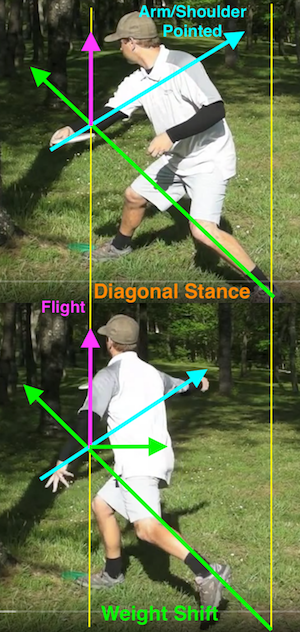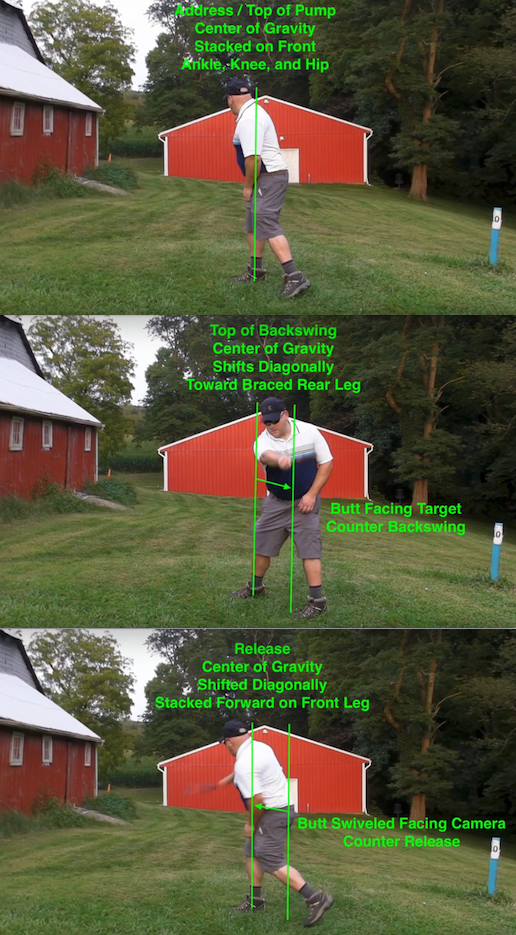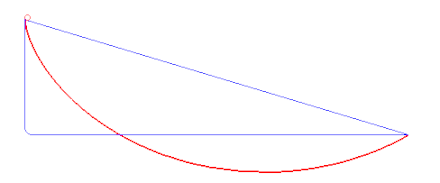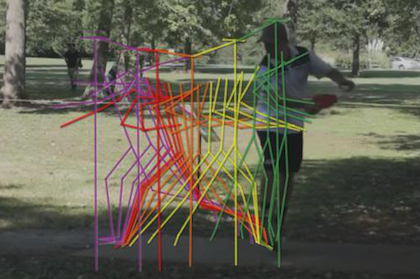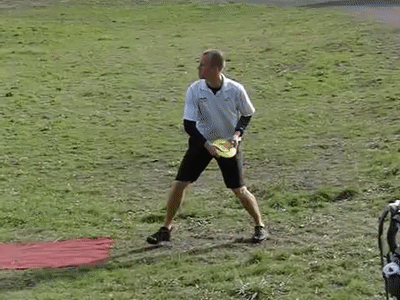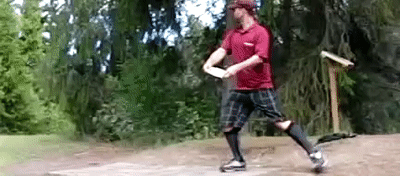HyzerUniBomber
* Ace Member *
This is a long ramble, feel free to ignore - but I've seen better distance than ever with this "ah-ha moment".
If you hadn't see it - it'd be hard to believe, but Garrett Gurthie has regularly out driven the biggest arms in the game. A dude who hasn't been on tour for some time, isn't built like an orangutan, and doesn't take much of an x-step... will out drive top pros by 50'.
https://www.youtube.com/watch?v=sPn9aoLSbEs
Why is that guy out throwing other big arms?
For most of the disc golfers who might peruse Tech and Strat only to shake their heads at the nerds, they've probably missed out on a number of conversations that have played out in the Form & Analysis forum in a number of threads. I will poke around from time to time and this meandering conversation started unlocking some ideas that I'd never fully solidified in my own thoughts about generating and using momentum for the purpose of a backhand drive.
I've been thinking, testing, adjusting, and writing about backhands for the better part of the last 4-5 years, but this was another moment where the lightbulb didn't just flicker for a second... it exploded. This is buried in the SlowPlastic tome.
What has unlocked power in this idea? The mental experiment of visualizing your forearm completely as a lever on a hinge at your elbow. What direction does the forearm lever need to be leveraged?
(homework, watch now with eyes on shift direction)
https://www.youtube.com/watch?v=7eD-JUyiRjI
https://www.youtube.com/watch?v=qpICK3NSQb0
The direction of your shift is not directly targetward. Why? Because as SlowPlastic pointed out somewhere, in baseball you're shifting your weight to maximize your leverage for where you swing the bat. When you look at an Olympic hammer throw, they're not shifting their weight towards where the hammer is going - they're shifting it where they maximize the leverage for where you accelerate the hammer!
In a backhand, the disc is coming out of your hand with your arm pointing at approximately 10:30 on a clock, assuming that 12:00 is the actual line the disc will fly on:
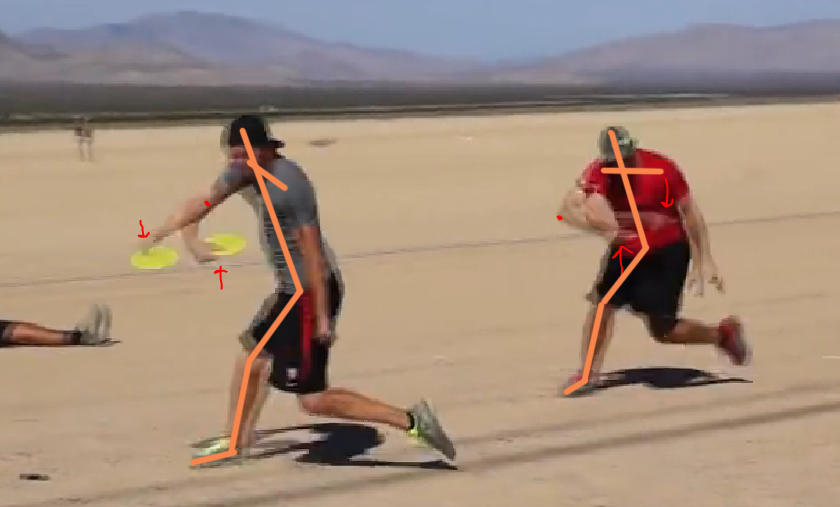
Somewhere in the archives of this site, I drew the ejection point and the redirection of the disc for an overhead of Dan Beto... couldn't find it.

So if the leverage for that forearm needs to maximize momentum from A. Hand on the outside ~ center chest to B. 10:30 arm extension where the disc pings out, then we have to shift about 20-30 degrees left of the line that we're throwing on (RHBH). If you shift straight targetward, in our example of a hammer throw, you'd be setup to throw the thing too far right. Same is true in discgolf, a straight targetward shift would only be appropriately powerful if you grip locked it and threw it 30 degrees too right!
When I started to see the ejection point as being at the 10:30 mark on the clock, I had to seriously shake my head because for so long, my shift into the brace didn't feel like I could get that position:
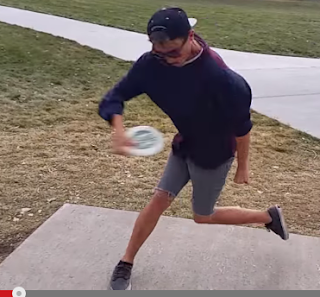
because I couldn't trap the momentum, I was shifting too straight - and Eagle was shifting the right direction. As soon as I shifted to maximize the leverage on my forearm arcing forward, my back leg smashed forward, just like Eagle!
When I add in the power of the downshift from getting up on just the back big toe, with the simplicity of the idea of throwing a brick or a basketball underhanded:
My power is now better than ever, and quite literally I'm using muscle only to hold my frame in the right positions, not to accelerate the arc forward.
If you hadn't see it - it'd be hard to believe, but Garrett Gurthie has regularly out driven the biggest arms in the game. A dude who hasn't been on tour for some time, isn't built like an orangutan, and doesn't take much of an x-step... will out drive top pros by 50'.
https://www.youtube.com/watch?v=sPn9aoLSbEs
Why is that guy out throwing other big arms?
For most of the disc golfers who might peruse Tech and Strat only to shake their heads at the nerds, they've probably missed out on a number of conversations that have played out in the Form & Analysis forum in a number of threads. I will poke around from time to time and this meandering conversation started unlocking some ideas that I'd never fully solidified in my own thoughts about generating and using momentum for the purpose of a backhand drive.
I've been thinking, testing, adjusting, and writing about backhands for the better part of the last 4-5 years, but this was another moment where the lightbulb didn't just flicker for a second... it exploded. This is buried in the SlowPlastic tome.
...
The conversations that have been happening in the various threads have been wonderfully enlightening for me, and I thought I'd sorta figured things out! The problem is that there's 2 pretty extremely different camps that are trying to accomplish the same thing - but through a different means.
There's the downshift camp, which is very obvious in the GG throws - he gets dead vertical on the toes of the back foot and then throws the underhand basketball forward.

Then there's the Will S camp from that original video, where he does the 1-step staying basically flat and and doing this: https://youtu.be/30cUNsWOYSI?t=196
which I personally dislike for a 1-step shot.
When I look at the 2 camps, I think the GG camp can generate power easier and with less wear and tear. My old videos on youtube are full of shots of me doing the Will S 1-step and I could generate some pretty good power, but that Will S is very incompatible with an x-step and it still didn't create the same power.
Furthermore, the Will S is very reliant on a whip-like motion with my arm. The GG motion just traps the momentum from the down shift and if the disc is loaded into the center chest, the momentum blasts it forwards. Same motion with an x-step.
Next up, I think SlowPlastic has nailed it with the diagram, and Lumberjacks's gif is spot on - and this is not just "shifting from behind" which I think is not the right terminology anymore - it's more like "shifting to trap the momentum" so that it's setup AT THE CENTER CHEST!
That's key, and I don't think I really put the words to it until we've had this group conversation. I don't want my momentum trapped and ready after my shoulders are opening, that's too late! We all know, and have long discussed the need to get the arc out front - and that it's a fundamental aspect to when the race starts.
But for this staggered-shift (and hopefully the down-shift) to work best, all the timing has to come together so the resistance of the brace pressured up against the frontside and rebounding inside the frame happens right through the extension. When you do that, the transfer of the momentum goes to the arcing forward disc.
I was able to start seeing the light with the concept of under-handing a basketball and thinking about a track and field hammer thrower.
...
What has unlocked power in this idea? The mental experiment of visualizing your forearm completely as a lever on a hinge at your elbow. What direction does the forearm lever need to be leveraged?
(homework, watch now with eyes on shift direction)
https://www.youtube.com/watch?v=7eD-JUyiRjI
https://www.youtube.com/watch?v=qpICK3NSQb0
The direction of your shift is not directly targetward. Why? Because as SlowPlastic pointed out somewhere, in baseball you're shifting your weight to maximize your leverage for where you swing the bat. When you look at an Olympic hammer throw, they're not shifting their weight towards where the hammer is going - they're shifting it where they maximize the leverage for where you accelerate the hammer!
In a backhand, the disc is coming out of your hand with your arm pointing at approximately 10:30 on a clock, assuming that 12:00 is the actual line the disc will fly on:

Somewhere in the archives of this site, I drew the ejection point and the redirection of the disc for an overhead of Dan Beto... couldn't find it.

So if the leverage for that forearm needs to maximize momentum from A. Hand on the outside ~ center chest to B. 10:30 arm extension where the disc pings out, then we have to shift about 20-30 degrees left of the line that we're throwing on (RHBH). If you shift straight targetward, in our example of a hammer throw, you'd be setup to throw the thing too far right. Same is true in discgolf, a straight targetward shift would only be appropriately powerful if you grip locked it and threw it 30 degrees too right!
When I started to see the ejection point as being at the 10:30 mark on the clock, I had to seriously shake my head because for so long, my shift into the brace didn't feel like I could get that position:

because I couldn't trap the momentum, I was shifting too straight - and Eagle was shifting the right direction. As soon as I shifted to maximize the leverage on my forearm arcing forward, my back leg smashed forward, just like Eagle!
When I add in the power of the downshift from getting up on just the back big toe, with the simplicity of the idea of throwing a brick or a basketball underhanded:
My power is now better than ever, and quite literally I'm using muscle only to hold my frame in the right positions, not to accelerate the arc forward.
